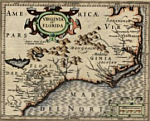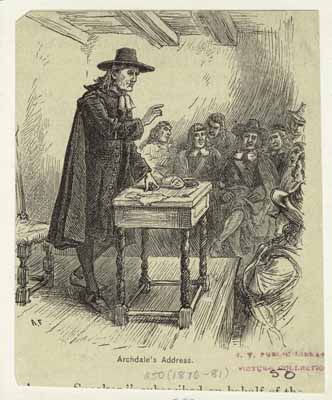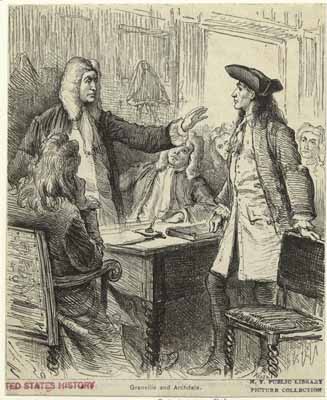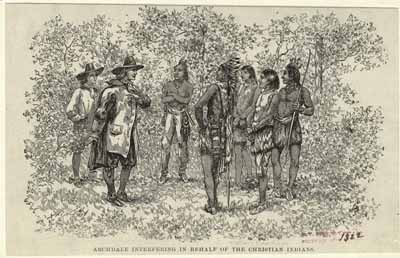ca. 5 May 1642–ca. 1710

John Archdale, colonial governor and proprietary shareholder of Carolina, was born in England, the son of Thomas and Mary Nevill Archdale and the grandson of Richard Archdale, a London merchant. Archdale's first connection with America came through the marriage of his sister Mary to Ferdinando Gorges the younger, one of the heirs to the proprietorship of Maine. Claim to the proprietary was contested by the Massachusetts government, which annexed Maine in 1652 and governed the province until the restoration of Charles II, when Gorges moved to make good his claim. Gorges ordered Charles II proclaimed in the province, commissioned civil officers in opposition to the Massachusetts ones, and appealed to the Privy Council for confirmation of his proprietary rights. When, in 1664, Gorges received confirmation of his title to Maine, he sent Archdale to make good his claim against Massachusetts and to settle the government of Maine on a sure foundation under authority of his charter. Archdale's visit, however, coincided with the visit of the Crown's commissioners for the reduction of New Netherlands and for the investigation of the New England governments. The Crown commissioners disallowed both the Massachusetts and the Gorges claims to the civil government of Maine and established a government directly responsible to the Crown. Archdale returned to England in 1665; in 1677, Gorges sold to Massachusetts his proprietary title to the soil of Maine.

In December 1673, Archdale married Ann Dobson Cary, a widow whose son by her previous marriage, Thomas Cary, was subsequently deputy governor of North Carolina. The Archdales had by this marriage one son, Thomas, and a daughter, Mary.
Archdale's conversion to Quakerism occurred some time after 1674. In 1678 he bought the Berkeley of Stratton share in the proprietary of Carolina, though he subsequently made over the title to his infant son, Thomas. In 1682 Archdale made plans to visit Carolina on behalf of the proprietors in order to collect quitrents and to help quiet the disturbances in the colony. He arrived in the fall of 1683 and remained for about three years, during which period he acted intermittently as governor of North Carolina.
In July 1694, Thomas Smith, governor of the southern part of Carolina, requested that the proprietors send out a new governor with full powers to deal with the unrest and dissension among the colonists. The proprietors commissioned Archdale governor of both halves of Carolina, and he made a tour of the English colonies on his way to assume the government of the proprietary. He landed in Maine early in 1695 and traveled south, visiting every colony en route to Charleston, which he reached in August 1695. Once in Charleston he set about "to allay the heates" of the people, to moderate the differences between Dissenters and Churchmen, and to choose a council and call an assembly. At this time he appointed as deputy governor of South Carolina Joseph Blake, who was to carry out in that province many of Archdale's plans for the colony; his deputy governor for North Carolina was Thomas Harvey, who was also sympathetic to Archdale's program of reforms and who carried on his program there. Archdale tried to deal fairly with Huguenot settlers in the face of hostility from the English-speaking settlers in South Carolina.

During Archdale's tenure as governor, the South Carolina assembly passed a number of important acts, since known as Archdale's Laws. A poor law, a comprehensive slave law, and in recognition of Archdale's Quaker principles, a law exempting conscientious objectors from military duty were enacted. In both Carolinas compromises were reached over quitrents and land sales. Archdale is credited by some with introducing to the Carolinas seed-rice from Madagascar. He oversaw the construction of improved public roads and (in South Carolina) military fortifications, and he showed great tact in his dealings with the Spanish governor of St. Augustine.
In return for his outstanding services to the two provinces, Archdale received votes of thanks from both the North and South Carolina assemblies. In 1696 Archdale's son, Thomas, sold the Berkeley of Stratton share in the proprietary of Carolina to Joseph Blake, and Archdale returned to England. In 1698, Archdale was elected to the House of Commons as member for Wycombe. However, when Archdale offered to affirm rather than swear the oath required of members, the House refused to seat him. A by-election was held, and his brother Thomas was elected to fill the vacant seat.

Archdale purchased the Sir William Berkeley share of Carolina in 1705 and for three years took an active part as a member of the proprietary board. On 22 Oct. 1708 he sold his proprietary share to his son-in-law and daughter, John and Mary Danson, and died "a year or two" afterward, according to contemporary testimony by Maurice Ashley, a fellow proprietor of Carolina.
Archdale wrote a short article, undated but probably after 1702, entitled "Weighty Considerations," and presented it to the House of Commons for its consideration. In 1707 he published a short tract entitled A New Description of that Fertile and Pleasant Province of Carolina with a Brief Account of Its Discovery and Settling and the Government thereof to this Time, with Several Remarkable Passages of Divine Providence during my Time.